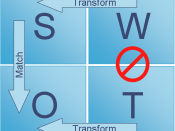Create, develop and discuss your own detailed taxonomy describing the components, structure, history and theoretical underpinnings of strategy. As the foundation of your taxonomy, include discussion of at least three significant theorists in the field, and provide a critically comparative view of the schools of strategic thought you consider most significant.
DEFINE TAXONOMY
Taxonomy is a systematic way of classifying knowledge. It provides a hierarchical structure of concepts, using terms that help in the development of a common language to aid knowledge sharing.
Taxonomy is probably the most familiar kind of organization or classification scheme used content management. The basic simple taxonomy is a hierarchy (or tree) with a top element (or root), depending on your preference for Top down or Bottom up design. Nodes (or branch points) are names for things (objects) or concepts. In a simple taxonomy, each item being classified fits in just one place in the taxonomy, with a single parent and any number of children.
DEFINE STRATEGY
According to Kenneth Andrews "Strategy is the pattern of decisions that determines and reveals its objectives, purposes, or goals, produces the principal policies and plans for achieving those goals, and defines the range of to pursue, the kind of economic and human organization it is or intends to be, and the nature of the economic and non-economic contribution it intends to make to its shareholders, employees, customers, and communities."
Henry Mintzberg, defined "strategy" in several different ways, the most common being these four:
Strategy is a plan, a "how," a means of getting from here to there.
Strategy is a pattern in actions over time; for example, a company that regularly markets very expensive products is using a "high end" strategy.
Strategy is position; that is, it reflects decisions to offer particular products or services in particular markets.


